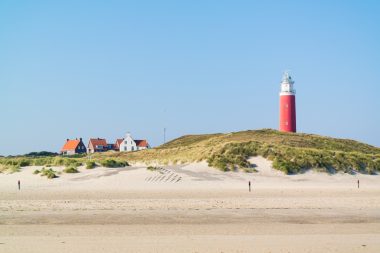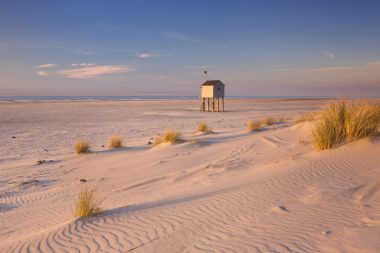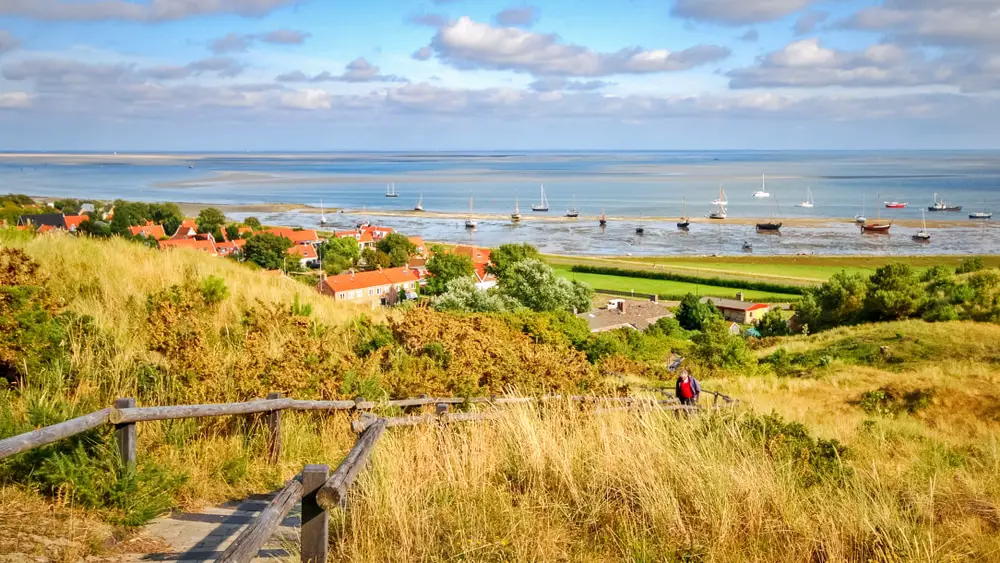On the Dutch side of the North Sea shore rests the counterpart to the East Frisian Islands. The West Frisian Islands score with wide sandy beaches, coastal panoramas with eye-catching lighthouses and a location on the UNESCO World Heritage Wadden Sea. Whether Texel, Vlieland, Terschelling, Ameland or Schiermonnikoog – the West Frisian Islands stand for a fascinating North Sea holiday, which is mainly characterised by untouched coastal nature.
Texel – The largest West Frisian island

As the largest of the West Frisian Islands in terms of area, Texel also has by far the highest population in the island region with around 13,500 inhabitants. Depending on the season, this considerable number of inhabitants is surpassed by the number of sheep that live here and enrich the island flair as animal inhabitants. They are a first indication that Texel is a real natural paradise in the North Sea . The specially protected nature areas De Hors and De Slufter represent the natural facets of Texel: while De Hors is characterised by its dune landscapes, De Sluter stands for a coastal green landscape where a wide variety of bird species such as seagulls, ducks and little terns feel at home. Those interested in local nature can visit the renowned Ecomare Museum of Natural History, which houses a seal sanctuary, a sea aquarium and a whale room. Whether cycling tours, guided mudflat hikes, classic nature hikes or scenic sightseeing – nature lovers will feel at home on the island. Another man-made landmark is the historic Texel lighthouse, which protects the island’s coastal region with its red façade.
Vlieland – Recreation near the sea on the mudflats
East of Texel is the much smaller island of Vlieland, which spreads over almost 40 km² – and thus takes up less than a third of the area of Texel. The predominantly car-free island is ideal for recreation near the sea. Vlieland is also all about the Wadden Sea, which has not been awarded by UNESCO for its natural beauty for nothing. A professional guide is recommended for a mudflat hike, but numerous mudflat hiking tours are offered on the island. One of the natural landmarks of the island is the Vliehors sandbank, which can be reached by De Vliehors Express, a prominent truck, when the weather is right. Boat tours to the seal populations of the region are also offered on the island. While the museum in Tromp’s Huys, the oldest house on the island, explains the history of the island, the foot of the Vuurduin Vlieland lighthouse presents all the natural beauty of the island’s panorama.
Terschelling – beach paradise in the North Sea

The beach of Terschelling stretches for 30 kilometres and is one of the most beautiful beaches of its kind on the Dutch coast. Almost even more striking is the width of the beach, which reaches up to one kilometer. With its origin in the Middle Ages, Terschelling is still a fairly young island that has its roots in a historic sandbank. With Het Behouden Huys , Terschelling has an important cultural-historical museum of the West Frisian Islands. If you are interested in the history of the island and the local seafaring, this is the place to be. In the west of the island, a striking building rises into the air: the Brandaris from the late 16th century. The historic lighthouse building is considered the oldest lighthouse in the Netherlands – it is still in use today. With the beautiful beach, the historic buildings and the special North Sea flair of the Netherlands, Terschelling provides further reasons for a holiday on the West Frisian Islands.
Ameland – island recreation between windmills and lighthouse
Despite its smaller size than Texel and Terschelling, Ameland is also one of the well-traveled island destinations in the Netherlands. Campsites, hotels and group accommodations underline the popularity that Ameland still enjoys today. At its heart, the island is dominated by four villages: Buren, Nes, Hollum and Ballum. The village of Nes forms the centre, where some sights and the harbour of the island are located. Here, for example, is the Natuurcentrum Ameland, which deals with the natural features of the West Frisian Islands. Ameland is a popular destination for nature lovers, especially cycling tours through the island landscape. And if you observe the beautiful nature of Amelund, you will also be able to discover the windmills De Verwachtung and De Phenix as well as the lighthouse in the middle of it. The latter is one of the most impressive buildings of its kind and has risen 55 meters since its construction in 1888.
Schiermonnikoog – Highlight for nature lovers
Actually the smallest of the inhabited West Frisian Islands, Schiermonnikoog is also one of the most fascinating travel destinations in the Dutch islands. Characterized by its location on the Wadden Sea, the Schiermonnikoog National Park also unfolds here, which, together with the Wadden Sea, shapes the nature of the island. Hundreds of thousands of visitors are drawn to the island every year, which is characterized by beach panoramas, dune landscapes and salt marshes. Of course, the lighthouse should not be missing from the island panorama, which in this case rises 37 meters into the air and was built in the middle of the 19th century. The easternmost of the five inhabited West Frisian Islands is home to just under 1,000 inhabitants and stands for natural recreation on the North Sea coast: a highlight for nature lovers.


